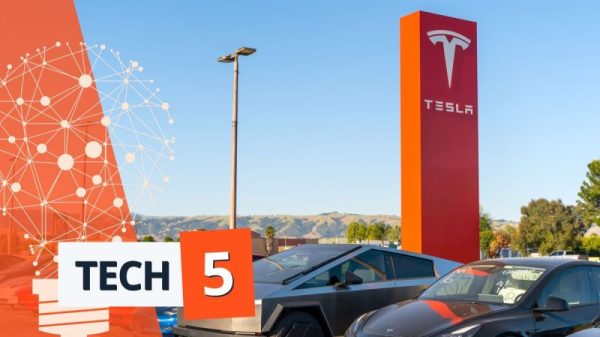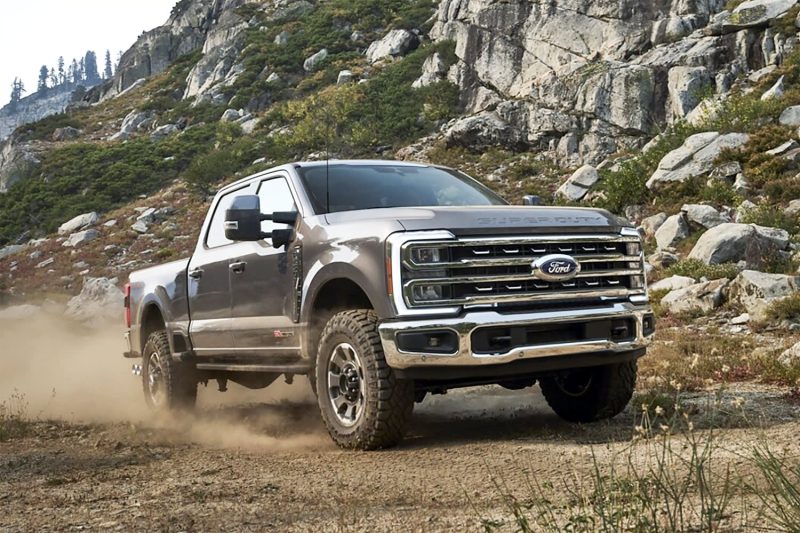DETROIT — A once “dirty” word, and business, in the automotive industry has become a multibillion-dollar battleground for U.S. automakers, led by Ford Motor.
The Dearborn, Michigan-based automaker has turned its fleet business, which includes sales to commercial, government and rental customers, into an earnings powerhouse. And Ford’s crosstown rivals General Motors and Chrysler parent Stellantis have taken notice, restructuring their operations as well.
“There’s much more of an emphasis now on profitability and how fleet can help that,” said Mark Hazel, S&P Global Mobility associate director of commercial vehicle reporting. ”[Automakers] are looking at how they strategically go about this. It’s been a very targeted approach with how they deal with fleets.”
Many fleet sales, especially daily rentals, have historically been viewed as a negative for auto companies. They are traditionally less profitable than sales to retail customers and are used by automakers at times as a dumping ground to unload excess vehicle inventories and boost sales.
But Ford has proven that’s not always the case by breaking out financial results for its “Ford Pro” fleet business. The operations have raked in about $18.7 billion in adjusted earnings and $184.5 billion in revenue since 2021.
Such results have led Wall Street to praise the business, as analysts have called it a “hidden gem” and Ford’s “Ferrari,” referring to the highly profitable Italian sports car manufacturer.
“No other company has Ford Pro. We intend to fully press that advantage,” Ford CEO Jim Farley said July 24 during the company’s second-quarter earnings call, in which Ford Pro was the dominant performer.
Fleet sales typically account for 18% to 20% of annual industrywide U.S. light-duty vehicle sales, which exclude some larger trucks and vans, according to J.D. Power.
Part of the opportunity in fleet sales comes from the aging vehicles on U.S. roadways. The average age of the 25 million fleet and commercial vehicles on American roads was 17.5 years last year, according to S&P. That compares with light-duty passenger vehicles at 12.4 years in 2023.
While commercial sales, which are viewed as the best fleet sales, are estimated to be slightly lower this year compared with 2023, both GM and Stellantis have recently redesigned and doubled down on such operations. However, neither reports such results out separately.
“Breaking apart the fleet channel, we see that Commercial sales have been the weakest. And zooming in further, there are just two [original equipment manufacturers] that appear especially challenged: STLA and, to a lesser extent, GM,” Wolfe Research said in an investor note Wednesday.
Meanwhile, Ford’s commercial volumes have increased a “strong” 7% this year compared with 2023, Wolfe said.
While fleet sales data isn’t as available as retail, Wolfe Research estimates Ford is by far the leader in such earnings at a forecast of $9.5 billion this year. That compares with North American operations at GM at $5.5 billion and Stellantis around $3.5 billion, Wolfe estimates.
S&P Global Mobility reports Ford has been the fleet leader for some time. Since 2021, Ford’s market share of new fleet vehicle registrations (categorized by businesses with 10 or more vehicles weighing under 26,000 pounds) has been about 30%. GM, meanwhile, had around 21%-22% during that time, and Stellantis about 9%.
GM, citing third-party data, claims it outsold Ford last year in a segment of fleet sales: commercial vehicles sold exclusively to businesses (with five or more vehicles) and not individual buyers.
Ford, meanwhile, said it counts “all customers who register their full-size, Class 1-7 truck or van under their business,” not just those with five or more vehicles.
Ford claims to lead sales of commercial vehicles, categorized as Class 1-7 trucks and vans, with a roughly 43% share of U.S. registrations through May of this year. That’s up 2.3 percentage points compared with a year earlier, the company said.
The Ford Pro business is led by sales of the automaker’s Super Duty trucks, which are part of its F-Series truck lineup with the Ford F-150, and range from large pickups to commercial trucks and chassis cabs.
It also covers sales of Transit vans in North America and Europe, all sales of the Ranger midsize pickup in Europe, and service parts, accessories and services for commercial, government and rental customers.
But automakers, including Ford, also see fleet operations as a key driver in other ways, including for electric vehicle sales, as well as reoccurring revenue options such as software and logistical services.
“This revenue has gross margins of 50-plus-percent which drives significant operating leverage and improved capital efficiency,” Farley said during the quarterly call. “The major part of this new software business is actually Ford Pro.”
Ford is aiming to achieve $1 billion in sales of software and services in 2025, led by its fleet and commercial business.
“Ford Pro is core to Ford, and there is potential upside on volumes as well as in software and service,” BofA’s John Murphy said Thursday in an investor note. “On software, Ford Pro accounts for ~80% of Ford’s software subscriptions with an attach rate of only 12%, which is projected to grow to 35%+ over the next few years.”
As Ford touts its fleet business, its closest rivals have amped up their operations.
Chrysler parent Stellantis is relaunching its “Ram Professional” unit this year with goals of achieving record profitability in 2025 and, eventually, becoming the No. 1 seller of light-duty commercial vehicles, which exclude some larger vehicles.
Christine Feuell, CEO of Stellantis’ Ram brand, declined to disclose a time frame for achieving that target but said the automaker believes it can do so after completely revamping its operations to focus on better mainstreaming operations for customers and earnings growth through sales and new services.
“It’s a highly profitable business. Not only on the product side, but on the services side,” she told CNBC during a media event last week. “Software and connected services are really a significant growth opportunity for us as well.
“We’re a little bit behind Ford in launching those services, but we definitely expect to see similar kinds of growth and revenues generated from those connected services.”
Ram makes up about 80% of Stellantis’ U.S. fleet and commercial business. It has a new or revamped lineup of trucks and vans coming to market, plus a host of connected and telematics products to assist fleet customers. It also increased the availability of financing and lending for commercial customers.
“This year truly begins our commercial offensive,” Ken Kayser, vice president of Stellantis North American commercial vehicle operations, said during the media event. “2024 is a foundational year for our brand, as we look to build momentum into 2025.”
GM isn’t sitting idle either. It has revamped its fleet and commercial business. It launched “GM Envolve” last year, its overhauled fleet and commercial business focused on fleet sales, digital telematics and logistics for commercial customers.
Sandor Piszar, vice president of GM Envolve in North America, said the Detroit automaker views the business as a competitive advantage not just to sell vehicles but to create reoccurring revenue and relationships with businesses.
GM Envolve, formerly known as GM Fleet, reorganized the automaker’s business to be a one-stop shop for fleet customers — from sales and financing to fleet management, logistics and maintenance.
“GM Envolve is a critically important piece of General Motors business. It’s a profitable business,” he told CNBC earlier this year. “We think it is a competitive advantage in the approach we’re taking in this consultative approach of a single point of contact and coordinating the full portfolio that General Motors has to offer.”
GM and Stellantis declined to disclose the earnings and profitability of their fleet businesses.
GM Envolve includes the company’s EV commercial business BrightDrop, which was folded back into the automaker last year instead of it acting as a subsidiary. It didn’t accomplish the growth GM had expected, but EVs have an opening for automakers’ fleet and commercial sales.
“BrightDrop is a great opportunity for General Motors and for GM Envolve,” Piszar said, citing all-electric vans specifically for last-mile deliveries as well as small local businesses. “There’s a lot of use cases and as we ramp up production and get customers to try the vehicle that’s a key piece of our model.”
Unlike retail customers, many fleet and commercial customers have predefined routes or schedules that could accommodate EVs well because they drive locally in a region and could charge overnight when electricity costs are lower.
S&P Global reports EV startup Rivian Automotive led the U.S. in all-electric cargo van registrations last year, roughly doubling Ford, its closest competitor, at No. 2.
While the upfront investment is high, automakers have argued the eventual payback could be worthwhile for some businesses.
All three of the legacy Detroit automakers are touting such advantages to their fleet customers, while still offering traditional vehicles with internal combustion engines.
Stellantis and Ford also have started highlighting their portfolios of different powertrains such as hybrids and plug-in hybrid electric vehicles as adoption of EVs has not occurred as quickly as many had expected.
Ford last month announced plans valued at about $3 billion to expand Super Duty production, including to “electrify” Super Duty trucks.
“We’ve gone to, on all of our commercial vehicles, a multi-energy platform so we will offer customers the choice that we think no other competitor will have,” Farley said during the earnings call. “We believe we will be a first mover, if not the first mover, in multi-energy Super Duty.”
— CNBC’s Michael Bloom contributed to this report.


































